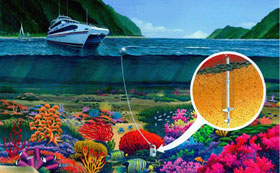
Environmental
 from: Audubon - Richardson Bay Wildlife Sanctuary
from: Audubon - Richardson Bay Wildlife Sanctuary
Eelgrass, Zostera marina L, is the most widely occurring marine angiosperm in world, growing throughout the west and east coast of the United Sates, Canada and along the coast of Baja California. Eelgrass habitat acts as a protective nursery ground for finfish and shellfish, as an important food source for waterbirds, and as protection to coastal areas against shoreline erosion.
Eelgrass in Richardson Bay
Eelgrass is a true plant (not a seaweed) that grows submerged or partially floating in the marine environment. Eelgrass reproduces through rhizome growth and seed germination. Eelgrass grows on muddy and sandy bottoms in the shallow subtidal environment. Eelgrass beds grow rapidly in the spring and summer, then decay in the fall and winter. Dead eelgrass blades often wash up on the beach where their decay adds crucial nutrients to coastal environments.
Full Article: All About Eelgrass
 Nantucket Harbor - Nantucket, MA
Nantucket Harbor - Nantucket, MA
by Dr. Sarah D. Oktay
Managing Director UMass Boston Nantucket Field Station
There is probably no single plant more important to our harbor ecosystem than eelgrass. We have relatively healthy beds of eelgrass in both harbors and in shallow areas around the island and the islands of Tuckernuck and Muskeget. The protection of eelgrass habitat is critical in order to have a viable bay scallop fishery. Eelgrass (Zostera marina L.) is a subtidal marine angiosperm (flowering plant), or "seagrass," that grows in temperate waters, often forming extensive underwater meadows. It is not seaweed, but actually an underwater submerged grass that flowers and primarily spreads via rhizomes or roots.
Full Article: No Eelgrass, No Scallops
Video 1
They are an ancient species of flowering plants that grow submerged in all of the world's oceans. Seagrasses link offshore coral reefs with coastal mangrove forests. Today, these "prairies of the sea," along with mangroves, are on the decline globally. Scientists fear the diminishing vegetation could result in an ecosystem collapse from the bottom of the food chain all the way to the top. Changing Seas joins experts in the field as they work to restore Florida's important mangroves and seagrasses.
Video 2
Visit the Shaw Ocean Discovery Centre! Sidney's award-winning aquarium of the Salish Sea.


Why is Eelgrass Important?
Eelgrass habitats are among the most productive and biologically diverse ecosystems on the planet. Living and dead plant material, including leaves, roots and rhizomes, has many valuable ecological functions such as stabilizing seafloor sediments and shorelines, cleaning coastal waters, providing habitat for a diversity of flora and fauna, and supporting the foundation of the detrital food web.
To learn more about the importance of sea grass and eelgrass beds click here: Eelgrass Video
Why Are Coral Reefs Important?
Hidden beneath the ocean's waters, coral reefs teem with life. Fish, corals, lobsters, clams, seahorses, sponges, sharks, and sea turtles are only a few of the hundreds of thousands of creatures that rely on reefs for their survival.
To learn more about the importance of coral reefs go here: http://celebrating200years.noaa.gov/foundations/coral/side.html
Why The Oceans Matter
Enjoy this short video from National Geographic.
 Seagrass Habitats
Seagrass Habitats  Coral Reefs
Coral ReefsThe Problem:
The more we learn about the complex relationship between the environment and our quality of life on Earth as a whole, the more we understand the importance of protecting it. Researchers have been studying changes in the marine environment looking for new ways to help protect this fragile ecosystem and sensitive sea bed areas. This is of particular importance near our shorelines & coral reefs, where human activities have caused the most obvious impact.
The Solution:
One of the ways that boaters can reduce boating related impacts, is to move away from traditional moorings, which require the use of heavy chains. These bottom chains being dragged around, cause crop circle patterns destruction to sensitive sea beds including eelgrasses & fragile coral reefs. We need to start doing a better job of protecting these life sustaining ecosystems.
More Photos
 Boat Anchor Dropped on Reef
Boat Anchor Dropped on Reef  Mooring Chain Dropped on Reef
Mooring Chain Dropped on Reef Mooring Field in Eelgrass
Mooring Field in Eelgrass  Eelgrass Scoured by Chain
Eelgrass Scoured by Chain